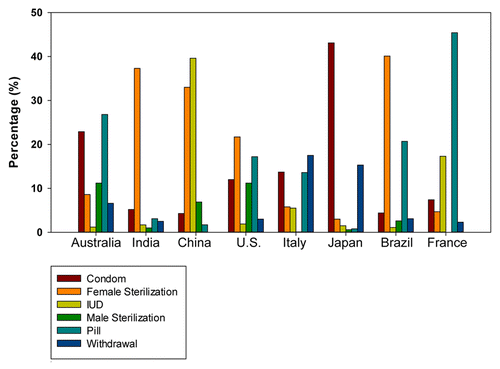Abstract
A recent article published in Bloomberg Businessweek1 has painted a grim picture of family planning practices in India by coercing women into sterilization. In the village of Sonhoula, 33 women, many of them poor, were forced into sterilization because each woman received either $10 or a modest increase in welfare benefits from local officials. These women accepted the offer out of desperation without receiving counseling on alternative birth control methods (Fig. 1). What is more striking is that the $10 accepted by these women is equivalent to 1 wk wages for a poor family, sufficient to feed at least three children. In the clinic, a medical assistant pricked each woman’s finger to test for anemia using the same needle. A surgeon then cut and tied each woman’s fallopian tubes with a rusted scalpel on a makeshift operating table (elevated from the floor with bricks and covered with a blood-stained sheet) in a 3 min operation. The scalpel was then washed with warm water and re-used for another patient. Women were then laid shoulder-to-shoulder on the floor in a separate room for recovery, with nurses walking around and offering painkillers. When the anesthetic ran out, the surgeon substituted a weaker drug, but since these women were not completely unconscious during the procedure, this medical practice is dangerous.
A recent article published in Bloomberg BusinessweekCitation1 has painted a grim picture of family planning practices in India by coercing women into sterilization. In the village of Sonhoula, 33 women, many of them poor, were forced into sterilization because each woman received either $10 or a modest increase in welfare benefits from local officials. These women accepted the offer out of desperation without receiving counseling on alternative birth control methods (). What is more striking is that the $10 accepted by these women is equivalent to 1 wk wages for a poor family, sufficient to feed at least three children. In the clinic, a medical assistant pricked each woman’s finger to test for anemia using the same needle. A surgeon then cut and tied each woman’s fallopian tubes with a rusted scalpel on a makeshift operating table (elevated from the floor with bricks and covered with a blood-stained sheet) in a 3 min operation. The scalpel was then washed with warm water and re-used for another patient. Women were then laid shoulder-to-shoulder on the floor in a separate room for recovery, with nurses walking around and offering painkillers. When the anesthetic ran out, the surgeon substituted a weaker drug, but since these women were not completely unconscious during the procedure, this medical practice is dangerous.
Figure 1. Contraceptive use among married couples, including women at ages 15‒49. This figure was prepared based on data at: http://www.prb.org/DataFinder/Topic/Rankings.aspx?ind=35 using the Filters of “All Methods, 2008, Percent.” Only eight selected countries are shown, and six of the most widely used contraceptives and/or practices are presented. It is worth noting that only 0.1% and 0% of men in Italy and France, respectively, adopted male sterilization in 2008.

As shown in , sterilization at 37.3% is the major contraceptive choice for women in India based on the latest available data from 2008 vs. 8.6%, 33%, 21.7%, 5.8%, 3%, 40.1%, and 4.7% in Australia, China, United States, Italy, Japan, Brazil, and France, respectively (). Besides sterilization, the male condom, pill, and vasectomy account for only 5.2%, 3.1%, and 1%, respectively, of contraceptive use by married couples in India; and the use of all other methods such as the IUD is negligible (). It is reported that 4.6 million Indian women at reproductive age can no longer have children because of forced sterilizations,Citation2 and some of these women may regret their uninformed decision later on in life.
It is obvious that much effort is needed to educate women in India as well as in other countries on available contraceptive choices such as the condom, pill, IUD, and others through Family Planning programs, and to improve sanitary conditions in clinics where the procedure is performed to avoid the transmission of blood-borne diseases such as HIV and hepatitis.
These reports also illustrate the urgency of developing safe, effective, economical, and reversible hormonal and non-hormonal male contraceptives to provide better choices for couples around the world. However, safe and effective male contraceptives will not be within our reach if we do not have a thorough understanding of mammalian spermatogenesis and also the function of other accessory organs that contribute to proper male reproductive function. It is hoped that these reports send a strong and clear message to governments and funding agencies that male contraceptive research, both hormonal- and non-hormonal-based, should be one of the priority areas and that funding should be allocated in line with other diseases such as cancer, neurological diseases (e.g., Alzheimer and Parkinson disease), and cardiovascular disorders. In fact, infertility is an emerging “disease” in developed countries right behind cardiovascular disease and cancer since infertility affects at least 15% of married couples, and half of these are contributed by a male factor(s).
Hopefully, these reports also remind established investigators the importance of training the next generation of young scientists in male reproductive sciences, including the molecular mechanisms that regulate spermatogenesis.
In this respect, Spermatogenesis is likely to play an important role through its publishing of high quality original research reports, views, opinions, commentaries, and review articles, which highlight the latest developments in spermatogenesis. Many of these findings may serve as a basis for continued male contraceptive research and as targets for contraceptive development.
Disclosure of Potential Conflicts of Interest
No potential conflicts of interest were disclosed.
References
- MacAskill A. Population control. Pushing Indian women toward sterilization. Bloomberg Businessweek June 24-June 30, 2013 pp. 18-19 (see also http://www.bloomberg.com/news/2013-06-11/india-s-poorest-women-coerced-into-sterilization.html)(2013).
- http://www.asianews.it/news-en/As-a-result-of-forced-sterilisations,-4.6-million-women-can-no-longer-have-children-in-India-28182.html).